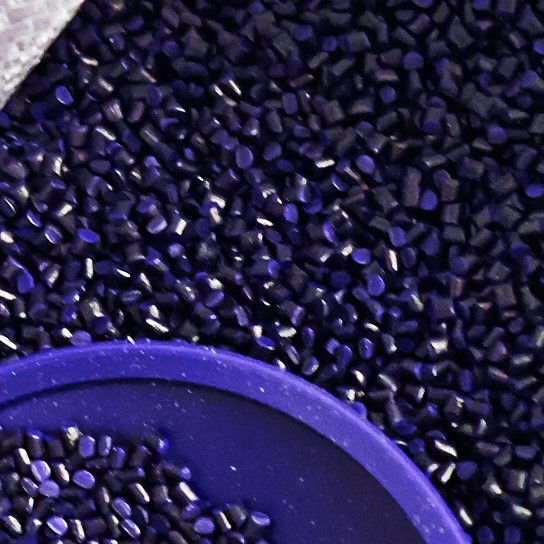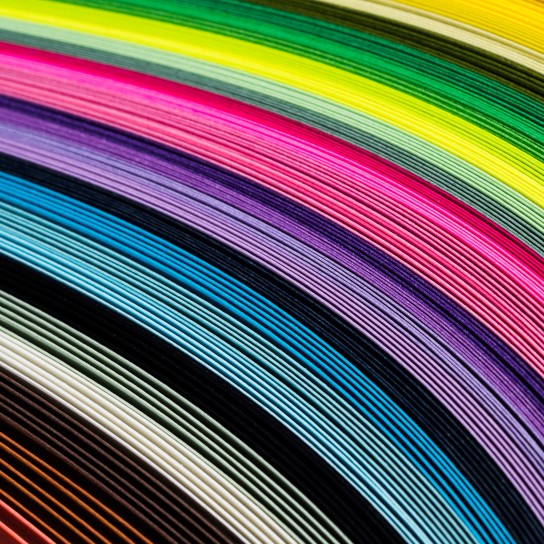Inorganic vs. Organic Pigments

Colors are an important part of our daily lives. From the clothing, cosmetics, and decorations we surround ourselves with to the foods we eat and how we communicate, color is an essential part of life, serving both aesthetic and functional purposes. As such, manufacturing colors is an important part of industry —but, how is color produced? Colorants for textile and cosmetic manufacturing are produced through the use of pigments. Pigments are insoluble solid materials that improve the appearance of or give color to a medium. As they are insoluble, they are added to the medium by grinding them into a fine powder and mixing them into the solution. Pigments change the way light transmits through or reflects off a surface by absorbing certain wavelengths of light. There are two primary types of pigments —organic and inorganic. It's important to understand what these types of pigments are and how they differ.
In this article you will learn:

Inorganic pigments
Inorganic pigments are not based on carbon chains and rings. Instead, they consist of dry ground minerals, usually metals and metallic salts. Because of their composition, inorganic pigments are usually more opaque and more insoluble than organic pigments. In general, inorganic pigments are the most commonly used in industry, favored for their lightfastness and low cost.
Inorganic pigments tend to be a popular choice in industry for numerous reasons, but they do have their drawbacks.

Properties of inorganic pigments
Some of the most significant positive and negative properties of inorganic pigments are:
- Excellent fade resistance: One benefit of inorganic pigments is their excellent resistance to fading when exposed to light. They also tend to be more resistant to fading when exposed to open air and heat.
- Cost-effective: Inorganic pigments tend to be cheaper to produce, especially in the large quantities needed for industrial applications. Much of this is due to the relatively simple chemical reactions needed to produce inorganic pigments.
- Poor tonality: While inorganic pigments tend to retain their color well, the color they produce by themselves is often dull. Improving tonality and brightness is often only possible when mixing inorganic pigments with organic pigments or dyes.
- Toxicity: Inorganic pigments tend to be more harmful to the environment due to the presence of lead salts in their composition. Some are even outright toxic , such as lead-based pigments.
Inorganic pigments list of examples
Titanium dioxide is one of the most widely used inorganic pigments. This opaque white pigment was developed in the 20th century and is extremely popular for its excellent color quality, high hiding power, nontoxic nature, and reasonable cost. It is most commonly used today as a way to provide opacity and lighten other colors. You'll most often see titanium dioxide labeled as titanium white.
White extender pigments are commonly used in industry to improve certain properties while keeping costs low. Some examples of these pigments include calcium carbonate, calcium sulfate, and china clays. Diatomaceous silica is another common type of white extender made from the remains of marine life.
Black pigments are primarily created from carbon particles. For example, carbon black is the most common pigment used in black printing inks.
Also known as natural iron oxide pigments, iron-oxide earth pigments comprise both oxides and oxide hydroxides of iron. This group of pigments creates the earthy ochres, siennas, and umbers found most commonly in paints. Hematite is the most common iron oxide used for red-tone colors like sienna, while hydroxide goethite is found in yellow-tone ochres. Iron and manganese oxides are used to produce brown-tone umbers.
French chemist Nicolas-Louis Vaquelin discovered chromium in 1797 and named it because so many colored compounds could be created from it. In 1809, chromium oxide was used as an enamel in porcelain factories, and it was used as a pigment in paintings as early as 1812. In the modern market, chromium compoundsare used to produce vibrant yellows, oranges, and greens.
Several compounds of cadmium are used in industry today to produce a range of yellows, oranges, reds, and maroons. These compounds are most commonly used to color plastics , but they're also used in ceramics, glass, and paint.
Aluminum and bronze are often used in industry to create metallic inks.
This iron-based pigment is also called Prussian blue, a name originating in the 18th century from the fact that the compound was used to dye the uniforms for the Prussian army. Consisting of iron cations, cyanide anions, and water, iron blue creates its dark blue color through oxidization.

Organic pigments
Organic pigments are based on carbon chains and rings. While some contain inorganic elements as stabilizers, organic pigments are defined primarily by this factor. These strong carbon chains also make them highly stable.
Carbon-based pigments are derived from animals, vegetables or synthetic organic chemistry. While traditional pigments were typically created using flora and fauna, the majority of modern pigments are created through synthetic organic chemistry. Synthetic organic pigments are most commonly derived from aromatic hydrocarbons including coal tars and other petrochemicals.

Organic pigment qualities
Organic pigments are marked by the following qualities:
- Color quality: While most organic pigments are considered transparent, their tonality is unparallelled. Organic pigments are characterized by bright, rich colors. They often provide powerful tint strength despite their transparency.
- High prices: Organic pigments tend to be more expensive to produce, especially synthetic organic pigments. Synthetic pigments require a great deal of chemical processing to produce, increasing the cost by volume.
- Varying lightfastness: There are many different varieties of organic pigments, but most of them tend to hold up poorly when exposed to light. While some can resist light and heat exposure well, many will fade over time.
Organic pigments tend to be less popular in most industries compared to inorganic pigments, with the exception of artists' paints. However, organic pigments are frequently used on a lesser scale in combination with inorganic pigments as this method improves the color quality of a product.
Organic pigments list of examples
Produced using the root of the madder plant, which also produces Alizarin dye, Alizarin crimson is a synthetic pigment that gained traction in the early 19th century. Also known as Madder red, this pigment can be used to produce various shades of red and red-purple.
Azo pigments are characterized by the fact that they contain a nitrogen group, but are historically significant as being one of the first synthetic organic pigments . Significantly more colorfast than many other types of organic pigments, Azo pigments produce many organic red, orange, and yellow pigments on the market today.
Copper phthalocyanines have been ruling the pigment industry since they were introduced in 1935 . Characterized by a brilliant shade, high strength, low cost, and surprising colorfastness despite being organic, this pigment is commonly used to produce strong blues and greens.
Discovered in the 1950s, quinacridone is a common pigment used in industrial and painting applications to produce reds and violets. Unlike many organic pigments, quinacridone exhibits excellent stability in light, heat, alkali, and solvents.

Main differences between organic and inorganic pigments
Organic and inorganic pigments are inherently different at a chemical level, but the differences extend further. When comparing the two pigment types, consider the following differences between organic vs. inorganic pigments:
- Brightness
- Chemical stability
- Color
- Cost
- Dispersion
- Light absorption
- Size
- Surface area
Organic pigments are generally brighter and better in tonal quality compared to inorganic pigments. However, this color tends not to last. For long-lasting products, producers prefer inorganic pigments because they tend to hold their color better in the presence of light and heat than organic pigments.
While organic pigments are very stable on their own, they dissolve in the presence of organic solvents and heat more easily than inorganic pigments. As a result, inorganic pigments tend to be more reliable in various applications.
The variety of colors available varies between organic and inorganic pigments —inorganic pigments come in a wider range than do organic pigments.
Inorganic pigment colors are more economical than organic colorants. Much of this cost difference has to do with manufacturing differences. While organic pigments must go through extensive chemical processing to produce a final product, the processes required for inorganic pigments are comparatively minimal.
Inorganic pigments are easier to disperse than organic pigments. As a result, inorganic pigments are easier to use in large-scale production and can be used for a wider variety of applications.
Pigments work by selectively absorbing wavelengths of light, but the process by which this occurs differs between organic and inorganic pigments. In organic pigments, the conjugated systems of double bonds within the molecules absorb the light. In inorganic pigments, on the other hand, the light is absorbed through electron transfer.
Organic pigments and inorganic pigments differ in particle size —inorganic pigments have significantly larger average particle sizes than organic pigments. Larger particles scatter light more effectively, preventing it from passing through the substance and resulting in better opacity. This is why organic pigments are considered transparent while inorganic pigments are opaque.
While organic pigments tend to be smaller in size than inorganic pigments, their surface area is generally larger. As a result, organic pigments tend to create stronger, brighter colors.
How to decide whether to use organic or inorganic pigments
When it comes to determining which type of pigment to use in your project, you need to consider the differences between organic and inorganic pigments and how they will affect your product. It's important to consider these factors and rate them in order of importance to decide which type of pigment to use. For example, if your project requires bright colors and is unlikely to be exposed to outside conditions, organic pigments may be your best choice. However, if color vibrancy is not as important as color resilience, inorganic pigments may be the best option for your application.
Generally, the following three factors are the most important:
Determine if the opacity of the color is important to your project. Organic pigments are transparent, while inorganic pigments are opaque. This means that a single layer of organic pigment may not be sufficient to create a good color layer, but a single layer of inorganic pigment may provide sufficient coverage to conceal the
If color vibrancy is important to your project, remember that organic pigments tend to create brighter colors than inorganic pigments. In certain cases, organic pigments or dyes can be used with inorganic pigments to create more vibrant colors.
If your project is going to be exposed to light and weather, and you need it to retain its color quality, then inorganic pigments may be more appropriate. While organic pigments are brighter, inorganic pigments are more resilient to sunlight, weather, and chemical exposure. There are some exceptions to this rule, so be sure to consider lightfast organic pigments if vibrancy is just as important as resilience.

Organic and inorganic pigments in the market
While organic and inorganic pigments have very different properties and advantages, both are experiencing excellent market growth. The organic pigments market was valued at approximately $3.51 billion in 2017 , and projections show it increasing to $4.89 billion by 2024, growing at a compound annual growth rate of 4.8% between 2018 and 2024. The inorganic pigments industry, on the other hand, was valued at about $20.7 billion in 2017 , and the global market is expected to expand at a 3.7% compound annual growth rate between 2018 and 2026.
Much of the difference in market value has to do with the stability and particle dispersion properties of inorganic pigments, which make them more valuable for the paint and cosmetics industries. There has been some slowdown in the inorganic pigments industry lately due to environmental concerns associated with the metallic byproducts of the production process, but this has only represented a minor setback in the market.
Explore your pigment options
When you're working with color, you need to work with pigments from a distributor you trust. If you're looking for quality products from a top distributor, Brenntag is here to help.
We are the top specialty and chemical distributor for a variety of industries. We provide high-quality raw materials for nearly any application, including pigments for the cosmetic, textile and painting industries . We know everything there is to know about both inorganic and organic pigments and can connect you with the resources you need to supply your next project.
We are a leading pigment solutions provider, offering a wide range of products . Our regional operating companies distribute our products across 190 locations , making it easy for you to connect with us and our products. Combined with our vast experience and our connections with some of the highest-quality suppliers in the world, we are the number one resource for all your raw chemical materials needs. Call us today at (800) 915-0027 or contact us online using the form to the right.